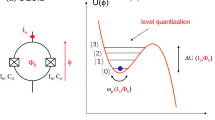Abstract
In this paper, we study coherent destruction of tunneling in driven spin-boson model. We formulate this physical process as a quantum optimal control problem. A running cost functional has been used to address the optimal control problem at hand. The dynamic is described by a Born–Markov master equation derived using the Bloch–Redfield formalism. We use the techniques of automatic differentiation to compute the gradient for the cost functional. We write the optimal control field as monochromatic plane wave. The robustness of the control profile against temperature and the system–bath coupling variations are also analyzed.
Graphical abstract

Similar content being viewed by others
References
M.A. Nielson, I.L. Chuang, Quantum Computation and Quantum Information (Cambridge University Press, Cambridge, 2000)
W.G. Unruh, Phys. Rev. A 51, 992 (1995)
P. Zanardi, M. Rasetti, Phys. Rev. Lett. 79, 3306 (1997)
D.A. Lidar, I.L. Chuang, K.B. Whaley, Phys. Rev. Lett. 81, 2594 (1999)
J. Preskill, Proc. R. Soc. Lond. A 454, 385 (1998)
E. Knill, R. Laflamme, L. Viola, Phys. Rev. Lett. 84, 2525 (2000)
P. Facchi, Pascazio, Phys. Rev. A 89, 080401 (2002)
L. Viola, S. Lloyd, Phys. Rev. A 58, 2733 (1998)
L. Viola, E. Knill, S. Lloyd, Phys. Rev. Lett. 82, 2417 (1999)
L. Viola, E. Knill, S. Lloyd, Phys. Rev. Lett. 83, 4888 (1999)
L. Viola, E. Knill, S. Lloyd, Phys. Rev. Lett. 85, 3520 (2000)
P. Zanardi, Phys. Lett. A 258, 77 (1999)
D. Vitali, P. Tombesi, Phys. Rev. A 59, 4178 (1999)
D. Vitali, P. Tombesi, Phys. Rev. A 65, 012305 (2001)
I. Walmsley, H. Rabitz, Phys. Today 56, 43 (2003)
H. Jirari, W. Pötz, Phys. Rev. A 72, 013409 (2005)
H. Jirari, Europhys. Lett. 87, 40003 (2009)
H. Jirari, W. Pötz, Phys. Rev. A 74, 022306 (2006)
R. Xu, Y. Yan, Y Ohtsuki, Y. Fujimira, H. Rabitz, J. Chem. Phys. Lett. 120, 6600 (2004)
O. Kocharovskaya et al., Phys. Rev. A 49, 4928 (1994)
D.H. Schirrmeister, V. May, Chem. Phys. Lett. 297, 383 (1998)
L. Hartmann, I. Goychuk, M. Grifoni, P. Hänggi, Phys. Rev. E 61, R4687 (2000)
J. Cai, S. Popescu, H.J. Briegel, Phys. Rev. E 82, 021921 (2010)
D. Zueco, P. Hänggi, S. Kohler, New J. Phys. 10, 115012 (2008)
J. Werschnik, E.K.U. Gross, J. Phys. B 40, R175 (2007)
L.S. Pontryagin, The Mathematical Theory of the Optimal Process (Wiley-, New York, 1962)
L. Hascoet, V. Pascual, TAPENADE 2.1 user’s guide, Rapport Technique 0300, INRIA, September 2004
H. Jirari, F.W.J. Hekking, O. Buisson, Europhys. Lett. 87, 28004 (2009)
H. Jirari, W. Pötz, Europhys. Lett. 77, 50005 (2007)
N. Barros, M. Rassam, H. Jirari, H. Kachkachi, Phys. Rev. B 83, 144418 (2011)
H. Jirari, N. Wu, Eur. Phys. J. B 89, 100 (2016)
M. Grifoni, P. Hänggi, Phys. Rep. 304, 1 (1998)
F. Grossman, T. Dittrich, P. Jung, P. Hänggi, Phys. Rev. Lett. 67, 516 (1991)
F. Grossman, P. Hänggi, Europhys. Lett. 61, 571 (1992)
I. Goychuck, P. Hänggi, Adv. Phys. 54, 525 (2005)
S. Kohler, J. Lehmann, P. Hänggi, Phys. Rep. 406, 379 (2005)
R.W. Munn, R. Silbey, J. Chem. Phys. 83, 1843 (1985)
N. Wu, K.-W. Sun, Z. Chang, Y. Zhao, J. Chem. Phys. 36, 124513 (2012)
K.M. Fonseca-Romero, S. Kohler, P. Hänggi, Phys. Rev. Lett. 95, 140502 (2005)
J. Stockburger, Phys. Rev. E 59, R4709 (1999)
E. Kierige et al., Phys. Rev. Lett. 100, 190405 (2008)
T. Tamayo-Mendoza, C. Kreisbeck, R. Lindh, A. Aspuru-Guzi, ACS Cent. Sci. 4, 559 (2018)
Yu. Maklin, G. Schön, S. Shnirman, Rev. Mod. Phys. 73, 357 (2001)
G. Wendin, V.S. Shumeiko, in Handbook of Theoritcal and Computational Nanotechnology, edited by M. Rieth, W. Schommers (ASP, Los Angeles, 2006), Vol. 3, pp. 223–309
T.P. Orlando et al., Phys. Rev. B 60, 15398 (1999)
J.E. Mooij et al., Science 285, 1036 (1999)
A.E. Bryson, Y.C. Ho, Applied Optimal Control (Hemisphere, New York, 1975)
J.T. Betts, Practical Methods for Optimal Control Using Nonlinear Programming (SIAM, Philadelphia, 2001)
C. Brif, R. Chakrabarti, H. Rabitz, New J. Phys. 12, 075008 (2010)
D.M. Gay, Usage Summary for Selected Optimization Routines, Computing Science Technical Report No 153, AT&T Bell Laboratories, 1990. https://doi.org/www.netlib.org/port
M. Grifoni, M. Winterstetter, U. Weiss, Phys. Rev. E 56, 334 (1997)
M. Grace et al., J. Phys. B 40, S103, (2017)
Author information
Authors and Affiliations
Corresponding author
Rights and permissions
About this article
Cite this article
Jirari, H. From quantum optimal control theory to coherent destruction of tunneling. Eur. Phys. J. B 92, 21 (2019). https://doi.org/10.1140/epjb/e2018-90231-5
Received:
Revised:
Published:
DOI: https://doi.org/10.1140/epjb/e2018-90231-5




